Electronic Journal: Southwest Journal of Pure and Applied Mathematics Internet:
advertisement
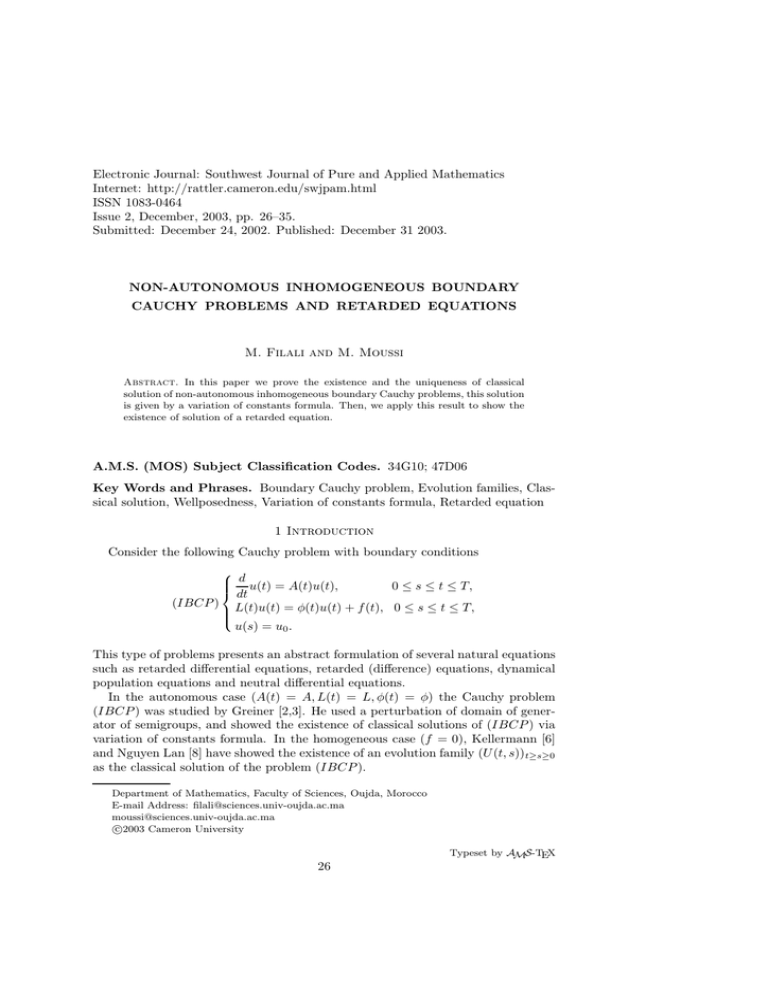
Electronic Journal: Southwest Journal of Pure and Applied Mathematics
Internet: http://rattler.cameron.edu/swjpam.html
ISSN 1083-0464
Issue 2, December, 2003, pp. 26–35.
Submitted: December 24, 2002. Published: December 31 2003.
NON-AUTONOMOUS INHOMOGENEOUS BOUNDARY
CAUCHY PROBLEMS AND RETARDED EQUATIONS
M. Filali and M. Moussi
Abstract. In this paper we prove the existence and the uniqueness of classical
solution of non-autonomous inhomogeneous boundary Cauchy problems, this solution
is given by a variation of constants formula. Then, we apply this result to show the
existence of solution of a retarded equation.
A.M.S. (MOS) Subject Classification Codes. 34G10; 47D06
Key Words and Phrases. Boundary Cauchy problem, Evolution families, Classical solution, Wellposedness, Variation of constants formula, Retarded equation
1 Introduction
Consider the following Cauchy problem with boundary conditions
d
0 ≤ s ≤ t ≤ T,
dt u(t) = A(t)u(t),
(IBCP ) L(t)u(t) = φ(t)u(t) + f (t), 0 ≤ s ≤ t ≤ T,
u(s) = u0 .
This type of problems presents an abstract formulation of several natural equations
such as retarded differential equations, retarded (difference) equations, dynamical
population equations and neutral differential equations.
In the autonomous case (A(t) = A, L(t) = L, φ(t) = φ) the Cauchy problem
(IBCP ) was studied by Greiner [2,3]. He used a perturbation of domain of generator of semigroups, and showed the existence of classical solutions of (IBCP ) via
variation of constants formula. In the homogeneous case (f = 0), Kellermann [6]
and Nguyen Lan [8] have showed the existence of an evolution family (U (t, s))t≥s≥0
as the classical solution of the problem (IBCP ).
Department of Mathematics, Faculty of Sciences, Oujda, Morocco
E-mail Address: filali@sciences.univ-oujda.ac.ma
moussi@sciences.univ-oujda.ac.ma
c
2003
Cameron University
Typeset by AMS-TEX
26
NON-AUTONOMOUS BOUNDARY CAUCHY PROBLEMS
27
The aim of this paper is to show well-posedness in the general case (f 6= 0) and
apply this result to get a solution of a retarded equation. In Section 2 we prove the
existence and uniqueness of the classical solution of (IBCP ). For that purpose,
we transform (IBCP ) into an ordinary Cauchy problem and prove the equivalence
of the two problems. Moreover, the solution of (IBCP ) is explicitly given by a
variation of constants formula similar to the one given in [3] in the autonomous
case. We note that the operator matrices method was also used in [4, 8, 9] for the
investigation of inhomogeneous Cauchy problems without boundary conditions.
Section 3 is devoted to an application to the retarded equation
v(t) = K(t)vt + f (t), t ≥ s ≥ 0,
(RE)
vs = ϕ.
We introduce now the following basic definitions which will be used in the sequel.
A family of linear (unbounded) operators (A(t))0≤t≤T on a Banach space X is called
a stable family if there are constants M ≥ 1, ω ∈ R such that ]ω, ∞[⊂ ρ(A(t)) for
all 0 ≤ t ≤ T and
k
Y
−k
R(λ, A(ti )) ≤ M (λ − ω) for λ > ω
i=1
for any finite sequence 0 ≤ t1 ≤ ... ≤ tk ≤ T.
A family of bounded linear operators (U (t, s))0≤s≤t on X is said an evolution family
if
(1) U (t, t) = Id and
U (t, r)U (r, s) = U
(t, s) for all 0 ≤ s ≤ r ≤ t,
(2) the mapping (t, s) ∈ R2+ : t ≥ s 3 (t, s) 7−→ U (t, s) is strongly continuous.
For evolution families and their applications to non-autonomous Cauchy problems
we refer to [1,5,10].
2 Well-posedness of Cauchy problem with boundary coditions
Let D, X and Y be Banach spaces, D densely and continuously embedded in
X, consider families of operators A(t) ∈ L(D, X), L(t) ∈ L(D, Y ) and φ(t) ∈
L(X, Y ), 0 ≤ t ≤ T . In this section we will use the operator matrices method in
order to prove the existence of classical solution for the non-autonomous Cauchy
problem with inhomogeneous boundary conditions
d
0 ≤ s ≤ t ≤ T,
dt u(t) = A(t)u(t),
(IBCP ) L(t)u(t) = φ(t)u(t) + f (t), 0 ≤ s ≤ t ≤ T,
u(s) = u0 ,
it means that we will transform this Cauchy problem into an ordinary homogeneous
one.
In all this section we consider the following hypotheses :
(H1 ) t 7−→ A(t)x is continuously differentiable for all x ∈ D;
(H2 ) the family (A0 (t))0≤t≤T , A0 (t) := A(t)|kerL(t) , is stable, with (M0 , ω0 ) constants of stability;
(H3 ) the operator L(t) is surjective for every t ∈ [0, T ] and t 7−→ L(t)x is continuously differentiable for all x ∈ D;
28
SOUTHWEST JOURNAL OF PURE AND APPLIED MATHEMATICS
(H4 ) t 7−→ φ(t)x is continuously differentiable for all x ∈ X;
(H5 ) there exist constants γ > 0 and ω ∈ R such that
||L(t)x||Y ≥ γ −1 (λ − ω)||x||X for x ∈ ker(λ − A(t)), λ > ω and t ∈ [0, T ].
Definition 2.1. A function u : [s, T ] −→ X is called a classical solution of (IBCP )
if it is continuously differentiable, u(t) ∈ D, ∀t ∈ [s, T ] and u satisfies (IBCP ). If
(IBCP ) has a classical solution, we say that it is well-posed.
We recall the following results which will be used in the sequel.
Lemma 2.1. [6,7] For t ∈ [0, T ] and λ ∈ ρ(A0 (t)) we have the following properties
i) D = D(A0 (t)) ⊕ ker(λ − A(t)).
ii) L(t)|ker(λ−A(t)) is an isomorphism from ker(λ − A(t)) onto Y.
−1
iii) t 7−→ Lλ,t := (L(t)|ker(λ−A(t)) ) is strongly continuously differentiable.
As consequences of this lemma we have L(t)Lλ,t = IdY , Lλ,t L(t) and (I − Lλ,t L(t))
are the projections in D onto ker(λ − A(t)) and D(A0 (t)) respectively.
In order to get the homogenization of (IBCP ), we introduce the Banach space E :=
X × C 1 ([0, T ], Y ) × Y, where C 1 ([0, T ], Y ) is the space of continuously differentiable
functions from [0, T ] into Y equipped with the norm kgk := kgk∞ + kg 0 k∞ , for
g ∈ C 1 ([0, T ], Y ).
Let Aφ (t) be a matrix operator defined on E by
A(t)
Aφ (t) :=
0
L(t) − φ(t)
0
0
−δt
0
0 , D(Aφ (t)) := D ×C 1 ([0, T ], Y )×{0}, t ∈ [0, T ],
0
here δt : C([0, T ], Y ) −→ Y is such that δt (g) = g(t).
To the family Aφ (·) we associate the homogeneous Cauchy problem
d
U(t) = Aφ (t)U(t),
(N CP ) dt
u
U(s) = f0 .
0 ≤ s ≤ t ≤ T,
0
In the following proposition we give an equivalence between solutions of (IBCP )
and those of (N CP ).
u 0
Proposition 2.1. Let f ∈ D × C 1 ([0, T ], Y ).
u1 (t)
(i) If the function t 7−→ U(t) := u2 (t) is a classical solution of (N CP ) with
0
u 0
f
. Then t 7−→ u1 (t) is a classical solution of (IBCP ) with initial
initial value
0
value u0 .
(ii) Let u be aclassical
solution of (IBCP ) with initial value u0 . Then, the
ufunction
0
u(t)
f
.
is a classical solution of (N CP ) with initial value
t 7−→ U(t) =
f
0
0
NON-AUTONOMOUS BOUNDARY CAUCHY PROBLEMS
29
Proof.. i) Since U is a classical solution, then, from Definition 2.1, u1 is continuously differentiable and u1 (t) ∈ D, for t ∈ [s, T ]. Moreover we have
0
U (t) =
u01 (t)
u02 (t)
0
φ
= A (t)U(t)
A(t)u1 (t)
0
=
L(t)u1 (t)−φ(t)u1 (t)−δt u2 (t)
(2.1)
.
Therefore
u01 (t) = A(t)u1 (t) and u02 (t) = 0.
This implies that u2 (t) = u2 (s) = f, ∀t ∈ [s, T ], hence the equation (2.1) yields to
L(t)u1 (t) = φ(t)u1 (t) + f (t), 0 ≤ s ≤ t ≤ T.
The initial value condition is obvious.
The assertion (ii) is obvious. Now we return to the study of the Cauchy problem (N CP ). For that aim, we recall
the following result.
Theorem 2.1. ( [11], Theorem 1.3) Let (A(t)) 0≤t≤T be a stable family of linear
operators on a Banach space X such that
i) the domain D := (D(A(t)), k · kD ) is a Banach space independent of t,
ii) the mapping t 7−→ A(t)x is continuously differentiable in X for every x ∈ D.
Then there is an evolution family (U (t, s)) 0≤s≤t≤T on D. Moreover U (t, s) has the
following properties :
(1) U (t, s)D(s) ⊂ D(t) for all 0 ≤ s ≤ t ≤ T , where D(r) is defined by
D(r) := x ∈ D : A(r)x ∈ D ,
(2) the mapping t 7−→ U (t, s)x is continuously differentiable in X on [s, T ] and
d
U (t, s)x = A(t)U (t, s)x for all x ∈ D(s) and t ∈ [s, T ].
dt
In order to apply Theorem 2.1, we need the following lemma.
Lemma 2.2. The family of operators (Aφ (t))0≤t≤T is stable.
Proof.. For t ∈ [0, T ], we write Aφ (t) as
0
Aφ (t) = A(t) + 0
−φ(t)
A(t)
where A(t) = 0
L(t)
0
0
−δt
0
0,
0
0 0
0 0 , with domain D(A(t)) = D(Aφ (t)).
0 0
30
SOUTHWEST JOURNAL OF PURE AND APPLIED MATHEMATICS
Since Aφ (t) is a perturbation of A(t) by a linear bounded operator on E, hence, in
view of a perturbation result ([10], Thm. 5.2.3) it is sufficient to show the stability
of (A(t))0≤t≤T .
x
Let λ > ω0 and f , we have
y
R(λ, A0 (t))
(λ−A(t))
0
0
0
1
λ
0
−Lλ,t x (λ − A(t))R(λ, A0 (t))x − (λ − A(t))Lλ,t y
f
0 f =
y
0
−L(t)R(λ, A (t))x + L(t)Lλ,t y
0
Since R(λ, A0 (t))x ∈ D(A0 (t)) = ker(L(t)), Lλ,t y ∈ ker(λ − A(t)) and L(t)Lλ,t =
IdY , we obtain
R(λ, A0 (t)) 0 −Lλ,t
1
(2.2)
(λ − A(t))
0 = I dE .
0
λ
0
0
0
x
On the other hand, for f ∈ D(A(t)), we have
0
R(λ, A0 (t))
0
0
0
1
λ
0
x
−Lλ,t
R(λ, A0 (t))(λ − A(t))x + Lλ,t L(t)x
.
f
0 (λ−A(t)) f =
0
0
0
¿From Lemma 2.1, let x1 ∈ D(A0 (t)) and x2 ∈ ker(λ − A(t)) such that x = x1 + x2 .
Then
R(λ, A0 (t))(λ − A(t))x + Lλ,t L(t)x = R(λ, A0 (t))(λ − A(t))(x1 + x2 )
+ Lλ,t L(t)(x1 + x2 )
= R(λ, A0 (t))(λ − A(t))x1 + Lλ,t L(t)x2
= x1 + x2
= x.
As a consequence, we get
R(λ, A0 (t))
0
0
0
1
λ
0
−Lλ,t
0 (λ − A(t)) = ID(A(t)) .
0
¿From (2.2) and (2.3) , we obtain that the resolvent of A(t) is given by
R(λ, A0 (t)) 0 −Lλ,t
1
R(λ, A(t)) =
0
0 .
λ
0
0
0
Hence, by a direct computation one can obtain, for a finite sequence 0 ≤ t1 ≤ ... ≤
tk ≤ T,
k
k
Y
Y
0
0
k
R(λ, A (ti )) 0 −
R(λ, A (ti ))Lλ,t1
Y
i=2
R(λ, A(ti )) = i=1
.
1
0
0
i=1
λk
0
0
0
NON-AUTONOMOUS BOUNDARY CAUCHY PROBLEMS
31
−1
¿From the hypothesis (H5 ), we conclude that ||Lλ,t || ≤ γ(λ − ω) for all t ∈ [0, T ]
andλ > ω. Define ω1 = max(ω0 , ω). Therefore, by using (H2 ), we obtain for
x
f
y
∈E
k
k
x k
Y
Y
Y
1 0
0
R(λ, A (ti ))Lλ,t1 y + k f R(λ, A(ti )) f = R(λ, A (ti ))x −
λ
y i=1
i=1
i=2
≤ M (λ − ω1 )
−k
+ (λ − ω1 )
||x|| + M (λ − ω1 )
−(k−1)
γ(λ − ω1 )
−1
||y||
−k
||f ||
x 0
f ≤ M (λ − ω1 )−k y ,
0
where M := max(M, M γ). Thus the lemma is proved. Now we are ready to state the main result.
Theorem 2.2. Let f be a continuously differentiable function on [0, T ] onto Y .
Then, for all initial value u0 ∈ D, such that L(s)u0 = φ(s)u0 + f (s), the Cauchy
problem (IBCP ) has a unique classical solution u. Moreover, u is given by the
variation of constants formula
u(t) = U (t, s)(I − Lλ,s L(s))u0 + Lλ,t f (t, u(t))
Z t
h
i
0
U (t, r) λLλ,r f (r, u(r)) − (Lλ,r f (r, u(r))) dr,
+
(2.4)
s
where (U (t, s))t≥s≥0 is the evolution family generated by A0 (t) and f (t, u(t)) :=
φ(t)u(t) + f (t).
Proof. First, for the existence of U (t, s) we refer to [7]. Since (Aφ (t))0≤t≤T is
stable and from assumptions (H1 ), (H3 ) and (H4 ), (Aφ (t))0≤t≤T satisfies all conφ
ditions of Theorem 2.1, then there exists an evolution
family
U (t, s) such
that,
for all initial value
u0
f
0
∈ D(Aφ (s)), the function
u1 (t)
u2 (t)
0
:= U φ (t, s)
u0
f
0
is
a classical solution of (N CP ). Therefore, from (i) of Proposition 2.1, u1 is a classical solution of (IBCP ). The uniqueness of u1 comes from the uniqueness of the
solution of (NCP) and Proposition 2.1.
Let u be a classical solution of (IBCP ), at first, we assume that φ(t) = 0, then
u2 (t) := Lλ,t L(t)u(t)
= Lλ,t f (t),
and u1 (t) := (I − Lλ,t L(t))u(t) are differentiable on t and we have
u01 (t) = u0 (t) − u02 (t)
= A(t)(u1 (t) + u2 (t)) − (Lλ,t f (t))
0
0
= A0 (t)u1 (t) + λLλ,t f (t) − (Lλ,t f (t)) .
32
SOUTHWEST JOURNAL OF PURE AND APPLIED MATHEMATICS
0
If we define f˜(t) := λLλ,t f (t) − (Lλ,t f (t)) , we obtain
u1 (t) = U (t, s)u1 (s) +
Z
t
U (t, r)f˜(r) dr.
s
Replacing u1 (s) by (I − Lλ,s L(s))u0 , we obtain
u1 (t) = U (t, s)(I − Lλ,s L(s))u0 +
Z
t
U (t, r)f˜(r) dr,
s
consequently,
u(t) = U (t, s)(I−Lλ,s L(s))u0 +Lλ,t f (t)+
Z
t
s
i
h
0
U (t, r) λLλ,r f (r) − (Lλ,r f (r)) dr. (2.5)
Now in the case Φ(t) 6= 0, since f (·, u(·)) is continuously differentiable, similar
arguments are used to obtain the formula (2.5) for f (·) := f (·, u(·)) which is exactly
(2.4). 3 Retarded equation
1
On the Banach space CE
:= C 1 ([−r, 0], E), where r > 0 and E is a Banach
space, we consider the retarded equation
(
v(t) = K(t)vt + f (t), 0 ≤ s ≤ t ≤ T,
(RE)
1
vs = ϕ ∈ C E
.
Where vt (τ ) := v(t + τ ), for τ ∈ [−r, 0], and f : [0, T ] −→ E.
Definition 3.1. A function v : [s − r, T ] −→ E is said a solution of (RE), if it is
continuously differentiable, K(t)vt is well defined, ∀t ∈ [0, T ] and v satisfies (RE).
In this section we are interested in the study of the retarded equation (RE), we will
apply the abstract result obtained in the previous section in order to get a solution
of (RE). As a first step, we show that this problem can be written as a boundary
Cauchy one. More precisely, we show in the following theorem that solutions of
(RE) are equivalent to those of the boundary Cauchy problem
d
dt u(t) = A(t)u(t), 0 ≤ s ≤ t ≤ T, (3.1)
0
(IBCP )
L(t)u(t) = φ(t)u(t) + f (t),
(3.2)
u(s) = ϕ.
(3.3)
Where A(t) is defined by
(
A(t)u := u0
D := D(A(t)) = C 1 ([−r, 0], E),
L(t) : D −→ E : L(t)ϕ = ϕ(0) and φ(t) : C([−r, 0], E) −→ E : φ(t)ϕ = K(t)ϕ.
Note that the spaces D, X and Y in section 2, are given here by D := C 1 ([−r, 0], E),
X := C([−r, 0], E) and Y := E.
We have the following theorem
NON-AUTONOMOUS BOUNDARY CAUCHY PROBLEMS
33
0
Theorem. i) If u is a classical solution of (IBCP ) , then the function v defined
by
(
u(t)(0),
s ≤ t ≤ T,
v(t) :=
ϕ(t − s), −r + s ≤ t ≤ s,
is a solution of (RE).
ii) If v is a solution of (RE), then t 7−→ u(t) := vt is a classical solution of
0
(IBCP ) .
0
Proof. i) Let u be a classical solution of (IBCP ) , then from Definition 2.1, v
is continuously differentiable. On the other hand, (3.1) and (3.3) implies that u
verifies the translation property
(
u(t + τ )(0),
s≤t+τ ≤T
u(t)(τ ) =
ϕ(t + τ − s), −r + s ≤ t + τ ≤ s,
which implies that vt (·) = u(t)(·). Therefore, from (3.2), we obtain
v(t) = u(t)(0)
= L(t)u(t)(·) + f (t)
= K(t)u(t)(·) + f (t)
= K(t)vt (·) + f (t).
Hence v satisfies (RE).
ii) Now, let v be a solution of (RE). From Definition 3.1, u(t) ∈ C 1 ([−r, 0], E) =
D(A(t)), for s ≤ t ≤ T . Moreover,
L(t)u(t) = u(t)(0)
= v(t)
= K(t)v(t) + f (t)
= φ(t)u(t) + f (t).
The equation (3.1) is obvious. 0
This theorem allows us to concentrate our self on the problem (IBCP ) . So, it
remains to show that the hypotheses (H1 ) − (H5 ) are satisfied.
The hypotheses (H1 ), (H3 ) are obvious and (H4 ) can be obtained from the assumptions on the operator K(t). For (H2 ), let ϕ ∈ D(A0 (t)) = ϕ ∈ C 1 ([−r, 0], E) ; ϕ(0) = 0 and f ∈ C([−r, 0], E)
such that (λ − A0 (t))ϕ = f, for λ > 0. Then
λτ
ϕ(τ ) = e ϕ(0) +
Z
0
eλ(τ −σ) f (σ) dσ,
τ ∈ [−r, 0].
τ
Since ϕ(0) = 0, we get
0
(R(λ, A (t))f )(τ ) =
Z
0
eλ(τ −σ) f (σ) dσ.
τ
34
SOUTHWEST JOURNAL OF PURE AND APPLIED MATHEMATICS
By induction , we can show that
k
Y
i=1
0
R(λ, A (ti ))f
!
(τ ) =
1
(k − 1)!
Z
0
(σ − τ )k−1 eλ(τ −σ) f (σ) dσ,
τ
for a finite sequence 0 ≤ t1 ≤ ... ≤ tk ≤ T. Hence
! Z 0
k
Y
1
k−1 λ(τ −σ)
0
(σ − τ )
e
dσkf k
R(λ, A (ti ))f (τ ) ≤
(k − 1)! τ
i=1
= eλτ
=
∞
i
X
λi−k (−τ )
i=k
∞
λτ X
e
λk
i=k
i!
i
(−λτ )
kf k
i!
1
≤ k kf k,
λ
Therefore
kf k
for τ ∈ [−r, 0].
k
Y
1
0
R(λ, A (ti ))f ≤ k kf k,
λ
i=1
λ > 0.
This proves the stability of A0 (t))t∈[0,T ] .
Now, if ϕ ∈ ker(λ − A(t)), then ϕ(τ ) = eλτ ϕ(0), for τ ∈ [−r, 0]. Hence
kL(t)ϕk = kϕ(0)k
= ke−λτ ϕ(τ )k,
since lim
λ→+∞
e−λ·
= +∞, in CE , we can take c > 0 such that
λ
e−λ·
λ
≥ c, therefore
kL(t)ϕk ≥ cλkϕk, ∀t ∈ [0, T ].
So (H5 ) holds. As a conclusion, we get the following corollary
Corollary 3.1. Let f be a continuously differentiable function from [0, T ] onto E,
1
then for all ϕ ∈ CE
such that, ϕ(0) = K(s)ϕ + f (s), the retarded equation (RE)
has a solution v, moreover, v satisfies
vt = T (t − s)(ϕ − eλ· ϕ(0)) + eλ· f (t, vt ) +
Z
t
s
0
T (t − r)eλ· λf (r, vr ) − (f (r, vr )) dr,
where (T (t))t≥0 is the c0 -semigroup generated by A0 (t).
References
1. K.J. Engel and R. Nagel, One-Parameter Semigroups for Linear Evolution Equations, Graduate Texts in Mathematics 194, Springer-Verlag, 2000.
2. G. Greiner, Perturbing the boundary conditions of a generator, Houston J. Math. vol 13,
213-229 (1987).
NON-AUTONOMOUS BOUNDARY CAUCHY PROBLEMS
35
3. G. Greiner, Semilinear boundary conditions for evolution equations of hyperbolic type, Lecture
Notes in Pure and Appl. Math. vol 116 Dekker, New York, 127-153 (1989).
4. R. Grimmer and E. Sinestrari, Maximum norm in one-dimensional hyperbolic problems,
Diff. Integ. Equat. vol 5, 421-432 (1992).
5. T. Kato,, Linear evolution equations of ”hyperbolic” type, J. Fac. Sci. Tokyo. vol 17, 241-258
(1970).
6. H. Kellermann, Linear evolution equations with time dependent domain, Tübingerbericht
Funktionalanalysis, 15-44 (1986-1987).
7. N. T. Lan, On nonautonomous Functional Differential Equations, J. Math. Anal. Appl. vol
239, 158-174 (1999).
8. N. T. Lan, G. Nickel, Time-Dependent operator matrices and inhomogeneous Cauchy Problems, Rendiconti Del circolo matematico di Palermo. XLVII, 5-24 (1998).
9. R. Nagel and E. Sinestrari, Inhomogeneous Volterra integrodifferential equations for HilleYosida operators, Marcel Dekker, Lecture Notes Pure Appl. Math. vol 150, 51-70 (1994).
10. A. Pazy, Semigroups of linear operators and applications to partial differential equations,
New york Springer, 1983.
11. N. Tanaka, Quasilinear evolution equations with non-densely defined operators, Diff. Integral
Eq. vol 9, 1067-1106 (1996).
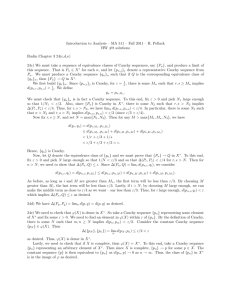

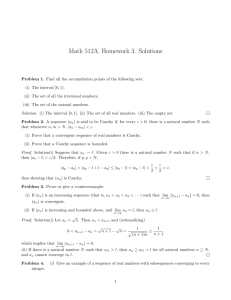
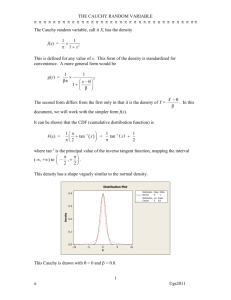
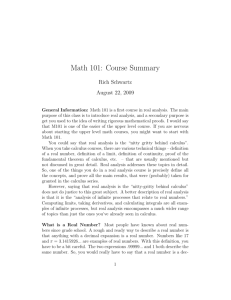
![OPERATOR THEORY Solution II 1. Let B ∈ B(C([0,1])) be defined](http://s3.studylib.net/store/data/008151749_1-0b6152ae34e314a74abfebeaf1cc2b35-300x300.png)